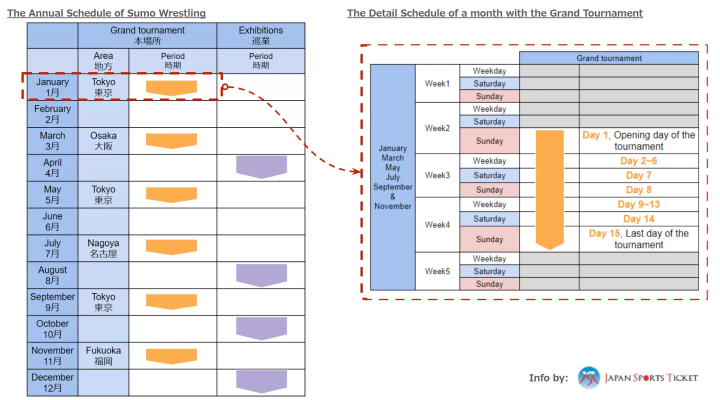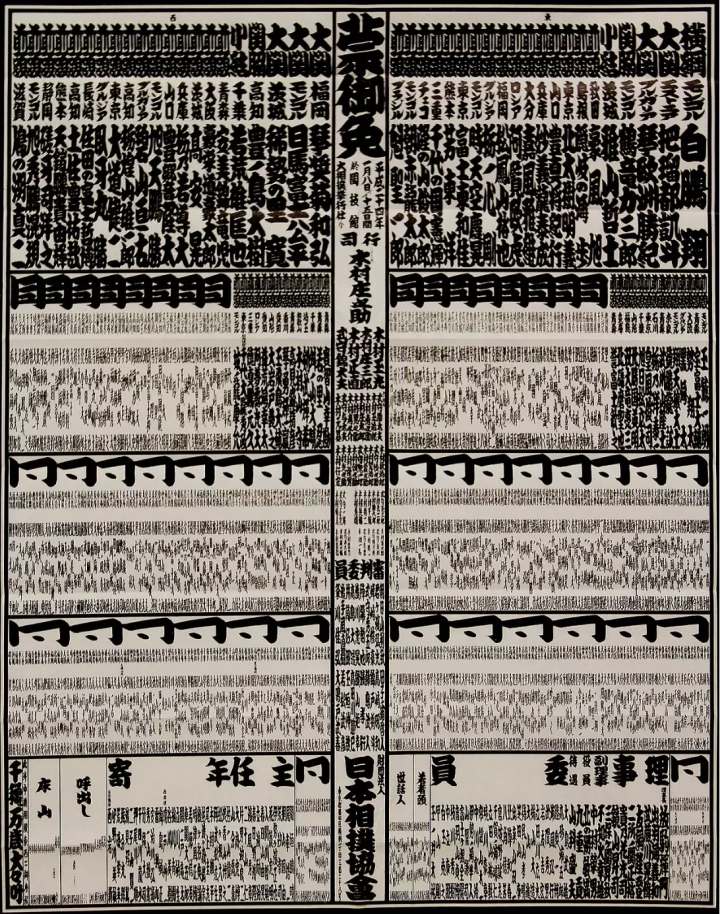2024 Sumo Complete Guide: Match schedule, how to enjoy it, and much more

Do you want to know everything about Sumo wrestling, Japan's traditional sport? We introduce the types of matches, the match schedule, how to watch, the atmosphere of the venue, the food, how to enjoy, etc. Why not travel back in time to Japan 200 years ago and watch a exciting Sumo wrestling?
-
Table of Contents
- Sumo in Japan
- Japanese Sumo Wrestling competitions
- Japanese Sumo Wrestling schedule
- The seating information of the arenas
- How to enjoy Sumo wrestling!
- What is “Banzuke” in sumo?
- Advanced: History of sumo in Japan
- Let's take a look at Japan's traditional sport, Sumo!
Sumo in Japan
Sumo wrestling is one of Japan's most traditional sports. Two wrestlers match up, and the winner is determined by whether one of them falls down or is pushed out of the Sumo ring (or "Dohyo"). Sumo wresting is so popular in Japan that it is broadcasted on TV every day. You will be able to experience the atmosphere of Japan about 200 years ago at the arena that will stimulate your five senses, such as the smell of the ring and the voices of the fans.
This article tell you about how to enjoy the traditional Japanese culture of Sumo wrestling, especially the Grand tournaments and the Exhibition series (Japan's most famous match organized by the Japan Sumo Association).
Japanese Sumo Wrestling competitions
There are two main types of sumo competitions, "the Grand tournament" and "the Exhibition series". You can attend both, and each has its own characteristics.
The Grand tournament (6 times a year)
The Grand tournament (or "Honbasho") is the official tournament of Sumo wrestling. It is the highest level of competition, so something similar to the Major League Baseball in America, or the Premier League in British soccer. The Grand tournament are held six times a year in odd-numbered months, and is held every day for 15 consecutive days. The results will determine the ranking of the sumo wrestlers of the next series. There are also matches where they can receive additional rewards if one wins, and whether or not one can receive them depends on the result of the match. As a result, the sumo wrestlers will fight in such game even more seriously.
The location of the Grand tournament are already fixed, and are held in four cities: Tokyo (January, May, September), Osaka (March), Nagoya (July), and Fukuoka (November). The matches are held every day for a total of 15 days, from the second Sunday of the month (around 8th to 14th) to the fourth Sunday of the month (around 22nd to 28th). Recently, many foreign tourists are watching the tournament. If you want to see the genuine and high level matches, we recommend watching the Grand tournaments.
Exhibition series (4 times a year, Spring / Summer / Fall / Winter)
The Exhibition series are held 4 times a year when there are no Grand series going on. The Sumo association provides the opportunities for the people who are not close to the Grand tournament venues to watch and interact with the professional wrestlers.
There are also events where you can get up close to the sumo wrestlers and get familiar with sumo, such as Q&As and taking photos. The Exhibition series is recommended for those who don't know much about sumo, as it can be fun and you may even get to interact with Sumo wrestlers. However, the Exhibitions are basically for people in rural areas other than big cities. Also, they are only held for one day in the same location, so it may be difficult to coordinate your travel plans.
You can choose one of the Sumo events that best suits you. With "Japan Sports Ticket", you can get tickets for sumo matches held at the Grand tournament or the Exhibitions, which are generally challenging for the tourists to get.
Japanese Sumo Wrestling schedule
Here is a summary of sumo's annual schedule.

Ticket sales for Sumo matches start about two months before the Day 1 of the tournament.
・About 2 months before: The presales lottery exclusive for Sumo fan club people
・About 1.5 month before: The presales lottery for ticket vendor membership only
・About 1 month before to the day: The public sales
The tickets for Sumo tournaments are quite popular. In particular, some popular days and popular seats often go sold out before the public sales.
At "Japan Sports Ticket", you can apply for the earliest presales lottery. There are only 3 spots available for this slot, so please contact us as soon as possible.
If you are the tourists from outside Japan, you can also consider the ticket vendor membership lottery. However, it may be quite challenging to deal with the Japanese ticket sales site. If you find it difficult to make reservations on your own, you may want to ask a professional staff for support.
"Japan Sports Ticket" welcomes your contacts directly via email, inquiry form, WhatsApp, etc.
To reserve Sumo tickets with "Japan Sports Ticket", we recommend contacting us at least two months in advance of the series. Early reservation is recommended! If you want to watch the Grand tournament of Sumo, please check the website.
The seating information of the arenas
There are two types of seats at the arenas where the Grand tournament will be held. One is that sit relatively close to the ring, and the other are the seats with chairs that surround them. There are some points that travelers should be aware of. At the seats where you can sit close to the ring ("Tamari" Seats and "Masu" Seats), you'll be seated directly on the floor with Japanese cushions. People with bad legs may feel uncomfortable. Also, the space to store the shoes is limited, so it may be better not to wear boots or high heels.
There are two types of seats where you can sit nearby and watch the game.
・"Tamari Seats": The seats closest to the ring are close to the wrestlers and you can have great view. Eating, drinking, and using cell phones are not allowed in Tamari seats. Children under the age of 15 cannot sit because the wrestlers may fall during the match.
・"Masu Seats": Masu is the area you sit behind the Tamari Seats. You'll sit in a group of 1 to 4 people and watch the game. You can eat and drink here.
In addition to these, there are chair seats.
・"Chair seats": Chair seats are relatively far from the sumo wrestlers, but they give you a better view of the match and the arena as a whole. You can eat and drink and the seats for a person are more spacious. The ticket prices are relatively cheap. At Ryogoku Kokugikan (the Tokyo venue), all the chairs are on the second floor. The below photo is the arena taken by "Japan Sports Ticket" staff from the chair seat areas.

When the "Japan Sports Ticket" staff actually went to watch sumo, they found more tourists in the chair seat areas. The seats where you sit and watch the game are designed based on the body size of Japanese people in the past. To modern people, it can be a bit small. You might need to bend your legs the entire time, so if you are not used to it, you may get tired before you can enjoy Sumo.
How to enjoy Sumo wrestling!
If you are watching sumo in Japan for the first time, you may have questions about the preparation before the day.
Sumo event daily schedule (opening time, ending time etc)
At the Grand tournament, you can watch all sumo matches that day with one ticket, generally starting from 8:00 AM to 6:00 PM. At first, there will be matches between young players or less experienced players. Famous players will appear in the afternoon. At around 3:30 pm, there is a "Dohyo-iri'' event in which high-ranked wrestlers, known as "Makuuchi", will show up and circle around the ring to greet each other before the matches. Then, the final match of the day will be held just before 6:00 PM, and the excitement reaches its climax as the highest-ranked players show up. Therefore, you should definitely watch the games after 5:00 PM. You can watch as many games as you like before then, so please schedule your time as you want.
What to bring and wear when watching Sumo
Next is about the things to bring and what to wear. Generally you can wear casual at the arena. As mentioned earlier, if you are sitting in a chair seats, you might want to bring binoculars. Also, large hats may get in the way of people behind you.
The gourmet while watching Sumo
In watching Sumo, unique foods are also something you might want to try.
"Chanko nabe" is the food that sumo wrestlers eat almost every day in Japan. "Chanko nabe" is a nutritious hotpot, with boiled seasonal vegetables, fish, and chicken in a large pot and eaten with delicious soup stock and ponzu sauce. This is a meal that not only players but also the fans often eat at the arena. You'll also find the "Chanko nabe" restaurant around the arena. You can find the restaurant at the underground hall at Ryogoku Kokugikan in Tokyo.
Also, if you are watching a game at Ryogoku Kokugikan in Tokyo, "Hiyochan-yaki'' is also popular. "Hiyo-chanyaki" is a Japanese-style dessert shaped like "Hiyonoyama", the official character of the Japan Sumo Association. It is a sweet bun with custard cream, red bean paste, or matcha bean paste inside. Sometimes there are flavors that are limited editions.
In addition to "Chanko nabe" and "Hiyochan-yaki", sumo arena also sells delicious bento boxes, yakitori, and other meals for the fans. And except "Tamari" seats, you can drink and eat in "Masu" seats and "Chair" seats! Sumo is a traditional sport, but you don't have to be nervous. Just enjoy and watch the game with delicious Japanese food and drinks.
So, the Sumo tournament is not only about watching the impressive matches. Following the rules and the etiquette, and you can enjoy watching Sumo in all aspects.
What is “Banzuke” in sumo?
"Banzuke" is a ranking list of all the approximately 700 active wrestlers. Banzuke are handed out to sumo officials around two weeks after the tournament at the main venue. This system began around the Edo period.
First, let's talk about the ranks of the sumo wrestlers that appear in the banzuke. The names of the ranks of sumo wrestlers are ``Yokozuna'', ``Ozeki'', ``Sekiwake'', ``Komusubi'', ``Maegashira'', ``Juryo'', ``Makushita'', ``Sandanme'', ``Jou Nidan'', and ``Junidan''. There are 10 ranks of "Introduction". The 5 ranks up to ``Maegashira'' are called ``Makuuchi,'' and the 6 ranks up to ``Juryo'' are called ``Sekitori.'' There are approximately 70 sumo wrestlers at the rank of Sekitori and above, and they receive special treatment. For example, if you travel on tour or to a match, you will be traveling first class by plane, and if you are traveling by car, you will be driven by a driver. These are great things for sumo wrestlers who have large bodies and are physically demanding to move around!
Next, I will explain the "ranking table". In the ranking table, the higher the rank, the larger the font. Additionally, the ranking is divided into two parts, East and West, and wrestlers' names are placed in one of them. The reason why it is divided into two is that in the past, ranking tables were created separately for the east, centered on Tokyo, and the west, centered on Osaka and Kyoto. However, now there is no longer a rule that wrestlers belong to one organization or another based on their hometown. Nowadays, it is customary for the East to be slightly stronger than the West, even within the same class. Here's some trivia. This form of paralleling the rankings of East and West may seem difficult to understand at first glance, but it is said to suit Japanese sensibilities better than a simple unified ranking, and is also applied to rankings other than sumo. .

Advanced: History of sumo in Japan
For those who are more interested in sumo, I would like to introduce a little history of sumo. Sumo is a sport that has existed in Japan for over 1500 years. Sumo already existed in 712 AD. The 1500s was a time of war in Japan. During this period, sumo was widely practiced as combat training for samurai. In the 1800s, as Japan's politics became more stable, powerful people from all over Japan flocked to Tokyo (Edo). Sumo matches began to be held regularly, and people began to enjoy it as a sport. Over a long period of time, sumo became stylized, refined, and became a beloved culture. Even in modern times, if you step into a sumo match, you will be exposed to the world of sumo that has remained unchanged for about 200 years.
Let's take a look at Japan's traditional sport, Sumo!
Sumo, a traditional Japanese sport, is unique from the way it is watched to the rules. The winner or loser is determined very simply, so there is no need to have prior knowledge or understand the detailed rules. Why not take advantage of the opportunity to travel and see a game? Its power and atmosphere are sure to impress you.
After COVID, the number of foreign tourists visiting Japan has increased very much. Also it became more common to see them at sports stadiums. What we heard from them is the difficulty of purchasing tickets. Match information, ticket information, how to buy, procedures for getting tickets (language, payment, Japanese address and phone number required)...etc People often gave up halfway through because of the difficulty of the process. "Japan Sports Ticket" supports the tourists to visit the Japanese local sports games, hope the tourist enjoy a unique and unforgettable Japan trip!!
The contents on this page may partially contain automatic translation.

































![[THE BLOSSOM KYOTO] Awaken your senses with the Kyoto aesthetic that lives on in the hotel](https://resources.matcha-jp.com/resize/720x2000/2025/07/01-237865.webp)

